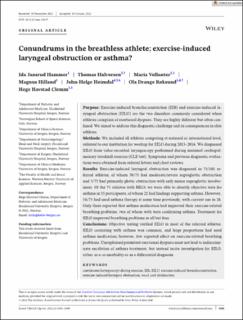| dc.contributor.author | Halvorsen, Thomas | |
| dc.contributor.author | Vollsæter, Maria | |
| dc.contributor.author | Hilland, Magnus | |
| dc.contributor.author | Heimdal, John-Helge | |
| dc.contributor.author | Røksund, Ola Drange | |
| dc.contributor.author | Clemm, Hege Synnøve Havstad | |
| dc.contributor.author | Hammer, Ida Jansrud | |
| dc.date.accessioned | 2022-08-04T09:08:01Z | |
| dc.date.available | 2022-08-04T09:08:01Z | |
| dc.date.created | 2022-05-20T11:12:53Z | |
| dc.date.issued | 2022 | |
| dc.identifier.citation | Scandinavian Journal of Medicine & Science in Sports. 2022, 32(6), Side 1041-1049. | en_US |
| dc.identifier.issn | 0905-7188 | |
| dc.identifier.uri | https://hdl.handle.net/11250/3010094 | |
| dc.description | This is an open access article under the terms of the Creative Commons Attribution-NonCommercial-NoDerivs License, which permits use and distribution in any medium, provided the original work is properly cited, the use is non-commercial and no modifications or adaptations are made. | en_US |
| dc.description.abstract | Purpose: Exercise-induced bronchoconstriction (EIB) and exercise-induced laryngeal obstruction (EILO) are the two disorders commonly considered when athletes complain of exertional dyspnea. They are highly different but often confused. We aimed to address this diagnostic challenge and its consequences in elite athletes.
Methods: We included all athletes competing at national or international level, referred to our institution for workup for EILO during 2013–2016. We diagnosed EILO from video-recorded laryngoscopy performed during maximal cardiopulmonary treadmill exercise (CLE test). Symptoms and previous diagnostic evaluations were obtained from referral letters and chart reviews.
Results: Exercise-induced laryngeal obstruction was diagnosed in 73/101 referred athletes, of whom 70/73 had moderate/severe supraglottic obstruction and 3/73 had primarily glottic obstruction with only minor supraglottic involvement. Of the 73 athletes with EILO, we were able to identify objective tests for asthma in 55 participants, of whom 22 had findings supporting asthma. However, 58/73 had used asthma therapy at some time previously, with current use in 28. Only three reported that asthma medication had improved their exercise-related breathing problems, two of whom with tests confirming asthma. Treatment for EILO improved breathing problems in all but four.
Conclusions: Objective testing verified EILO in most of the referred athletes. EILO coexisting with asthma was common, and large proportions had used asthma medication; however, few reported effect on exercise-related breathing problems. Unexplained persistent exertional dyspnea must not lead to indiscriminate escalation of asthma treatment, but instead incite investigation for EILO, either as a co-morbidity or as a differential diagnosis. | en_US |
| dc.language.iso | eng | en_US |
| dc.subject | continuous laryngoscopy during exercise | en_US |
| dc.subject | EIB | en_US |
| dc.subject | EILO | en_US |
| dc.subject | exercise-induced bronchoconstriction | en_US |
| dc.subject | exercise-induced laryngeal obstruction | en_US |
| dc.subject | vocal cord dysfunction | en_US |
| dc.title | Conundrums in the breathless athlete; exercise-induced laryngeal obstruction or asthma? | en_US |
| dc.type | Peer reviewed | en_US |
| dc.type | Journal article | en_US |
| dc.description.version | publishedVersion | en_US |
| dc.rights.holder | © 2022 The Authors | en_US |
| dc.source.pagenumber | 1041-1049 | en_US |
| dc.source.volume | 32 | en_US |
| dc.source.journal | Scandinavian Journal of Medicine & Science in Sports | en_US |
| dc.source.issue | 6 | en_US |
| dc.identifier.doi | 10.1111/sms.14137 | |
| dc.identifier.cristin | 2025920 | |
| dc.description.localcode | Institutt for idrettsmedisinske fag / Department of Sports Medicine | en_US |
| cristin.ispublished | true | |
| cristin.fulltext | original | |
| cristin.qualitycode | 2 | |
